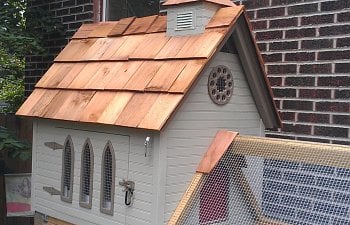My wife and daughters took me on Pittsburgh’s 2012 “Chicks in the Hood” tour. Prior to taking the tour, we agreed that if we heard the chickens or smelled the coops before we saw them we would not obtain our own “flock.” We were pleasantly surprised. I began researching the type of coop that would fit our needs. I liked the security of a small stationary coop, but also appreciated the options of a tractor style. In the end, I decided to build a hybrid – both stationary (with buried hardware cloth) and a mobile tractor.
We have a small backyard that is adjacent to our neighbors’, so I wanted to have a coop that looked nice. I researched extensively, mostly through backyardchickens.com, and learned the basic needs that should be included in a coop. Because I was purchasing new materials I decided to put some additional thought into the aesthetics. After a few sketches (see below), I decided to build a small coop in the style of a church, thus The Wee Kirk. It seems to be appropriate since I am a pastor.
I wasn't pleased with the appearance of the steeple sketches so I attempted to use Google Sketch to get a better view of what I was attempting to create.
Once I was pleased with the sketches, I began the construction.
The coop has large doors on both sides, for easy cleaning. I have painted the interior and the plywood floor is covered with vinyl so that the coop can easily be washed. I have one perch inside the coop. Ventilation comes through the three (total six) side windows, the two rose windows, the peaks of the side walls and the steeple is full of ventilation as well. Plexiglass sheets slide to cover the side and rose windows during winter months.
The coop is approximately 10 square feet and ideal for our two Gold-Laced Wyandottes and Buff Brahma Bantam. The run itself is approximately 35 square feet while in the stationary mode and closer to 25 square feet as a tractor. I have one laying box, which is placed where the “apse” of a church would be found. I was able to bend plywood to form the apse, which has its own access door.
Again, the birds are completely secure while the coop is stationary. However, as a tractor, predators could dig under the perimeter. I am not too concerned about this during daylight hours, but mostly concerned about nighttime predators. I wanted to create an automatic door locking mechanism which would prevent a predator from entering the coop at night. I saw some great designs on this website and designed a simple one. The door is opened from the outside by pulling on a vinyl-coated wire that is ran through a pulley and attached to the door that opens vertically. Gravity automatically locks the door when it is closed. (See below) I’ve also included a photo of bottom board of the tractor resting on the top board of the permanent base. I cut a 10 ft. 2x4 board in a “v” pattern.
Things I would/may change
1. Poop-Board – We are currently using sand in the coop. We will likely use pine shavings during the winter, so I need to make a poop-board from some leftover materials.
2. To help slide the tractor onto its permanent base, I have waxed (using a candle) the board that the tractor rests on. This has made it much easier to transition back to a stationary coop.
3. Eventually I will add a door to the permanent base and locate it under the coop. This will provide easy access to place food and water under the coop, which will provide shelter to the food and keep it out of the rain.
4. I have an electrical engineer friend working on a schematic for an automated door opener using a drill motor.

